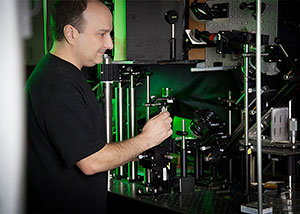Baldelli Receives $1 Million Keck Foundation Grant to Build Super Resolution Microscope
Improved Technique for Chemical Imaging of Surfaces

Steven Baldelli adjusts the original compressive-sensing, sum frequency generation microscope prototype. A new microscope, combining laser optics and high-resolution imaging, will give scientists a better way to study the chemical properties of surfaces, ranging from plastic and metal to cells and water.
The microscope will be built at the University of Houston thanks to a three-year, $1 million grant from the W. M. Keck Foundation to Steven Baldelli, an associate professor of chemistry at UH. Baldelli is collaborating with Kevin Kelly, an associate professor of electrical and computer engineering at Rice University.
“Surfaces are everywhere; however, studying their chemistry is a bit tricky since surfaces are often only one or two atoms thick,” Baldelli said. “Surfaces typically have different properties than the bulk of the material.”
Localized Details Come Into Focus
The microscope that Baldelli’s group is building will allow scientists to get more information about surfaces. The current technique, sum frequency generation or SFG, uses a laser and provides the overall surface’s chemical nature, but not the detailed chemistry of different regions across a surface and how they are reacting.
Baldelli says that knowing more about the various regions of a surface will be useful to many areas of science, including environmental science for studies of minerals and natural water surfaces and materials science where people make different materials such as metals, alloys and polymers.
“If you look at a piece of metal, some parts will be shiny, some dull, some rusty,” Baldelli said. “The chemistry is not uniform across the surface. This new microscope will capture and provide data for all the areas. Current techniques blur the details of specific regions.”
For the new microscope, Baldelli is combining SFG with a technique called compressive sensing imaging.
“The laser allows us to learn how surface molecules are behaving by looking at how the molecules interact with the laser’s light,” Baldelli said. “When the laser beam hits the sample, we recover the signal and analyze what happens after it hits. Does the sample absorb light, emit new signals of light, or change the polarization of the light?”
By adding in compressive sensing imaging, scientists can break apart the data into localized regions to see the reactions of the specific area.
Prototype Built and Tested
Before receiving the Keck Foundation grant, the Baldelli and Kelly groups built a prototype to prove that the concept would work. Baldelli and UH graduate student Xiaojun Cai worked on the chemistry and laser optics, while Kelly and his student Ting Sun manipulated the imaging data for analysis of the surface signals. Prototype development and testing also involved team member and UH alumnus, Bian Hu, who worked with the Rice group. The efforts resulted in a publication in the Journal of Chemical Physics.
“It took a couple of years and was built with spare parts, but we have been able to prove that the principle works,” Baldelli said. “We’ve shown that we can recover the images and surface signals.”
The grant will allow the team to purchase a laser that is faster, giving them the ability to construct a device with improved image resolution and speed of data acquisition.
Easy to Adopt New Technique Worldwide
More than 50 groups worldwide use the SFG technique for surface chemistry measurements. Baldelli says that once this new microscope is completed and fully tested it will be easy for scientists worldwide to adopt the added feature of compressive sensing.
“About two-thirds of the groups using SFG already have a laser with fast acquisition. Once we build and test this combined SFG and compressive-sensing microscope, other groups should be able to implement the technique without too much additional expense,” he said.
Based in Los Angeles, the W. M. Keck Foundation was established in 1954 by the late W. M. Keck, founder of the Superior Oil Company. The Foundation’s grant making is focused primarily on pioneering efforts in the areas of medical, science and engineering research. The Foundation also maintains an undergraduate education program that promotes distinctive learning and research experiences for students in the sciences and in the liberal arts, and a Southern California Grant Program that provides support for the Los Angeles community, with a special emphasis on children and youth from low-income families, special needs populations and safety-net services. For more information, please visit www.wmkeck.org.
- Kathy Major, College of Natural Sciences and Mathematics